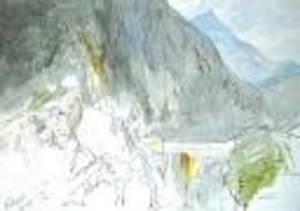The well-known nonsense poet and artist Edward Lear paid a short visit to Crete in 1864. He was coming from Corfu, where he had lived for nine years; when the British government returned the Ionian islands to the Greek state, the British community dispersed. At that point in his life he needed to find a warm place for his indifferent health and to produce another book like his Views in the Seven Ionian Islands, which had sold steadily. Lear chose Crete, and arrived in Chania on 11th April, with his faithful valet George Kokali and armed with Pashley’s Travels in Crete. Although he was aware of the presence of Venetian monuments and of some earlier ruins, what he was searching for were beautiful, exotic landscapes that he could sell in England, possibly in a book reworked from notes in his diary. Crete proved a disappointment in many respects. The landscape, vast, rugged and raw, did not lend itself to artistic composition according to the classical canons. The weather did not help and living conditions, from the food to the ever-present fleas and the state of the pavements, proved a perennial source of complaint. The only things that seemed to cheer him were the wine, the birds and the flowers. Lear took more notice of the latter than of the people. Unlike Pashley he makes very few ethnographical observations, even though he spoke Greek and took lodgings with local people.

Lear first travelled west in the Kissamos direction, venturing as far south as Topolia. He then went back to Chania for the Akrotiri and continued east to Souda and Aptera, cutting across to Vamos and Lake Kournas, finally sailing from Rethymnon to Megalokastro (i.e. Herakleion), which failed to impress him. He continued south, ascending Mt Juktas on the way. This he pronounced ‘Cumberlandish’, a term that he had already applied to Lake Kournas and of which he was obviously fond. The Mesara reminded him of the Beka’a Valley in Lebanon, but wanting in colours, lines and shape, and Mt Ida, around which he skirted from Tymbaki on his way north through the Amari Valley, was forever lost in the clouds. Lear was probably relieved to arrive back in England on 11th June. He had with him some 200 sketches and a diary: nothing of either was ever published in his lifetime. A few drawings were reworked and completed on commission and are now in the Ashmolean Museum in Oxford. The bulk of the sketches found their way onto the London art market in the late 1920s. The Gennadius Library in Athens has 92; the remainder are in private collections and museums. The diary was published in 1984.
An extract from Blue Guide Crete by Paola Pugsley. © Blue Guides. All rights reserved.
To mark the bicentenary of Lear’s birth, the Ashmolean Museum is currently running an exhibition entitled Happy Birthday Edward Lear: 200 Years of Nature and Nonsense.






